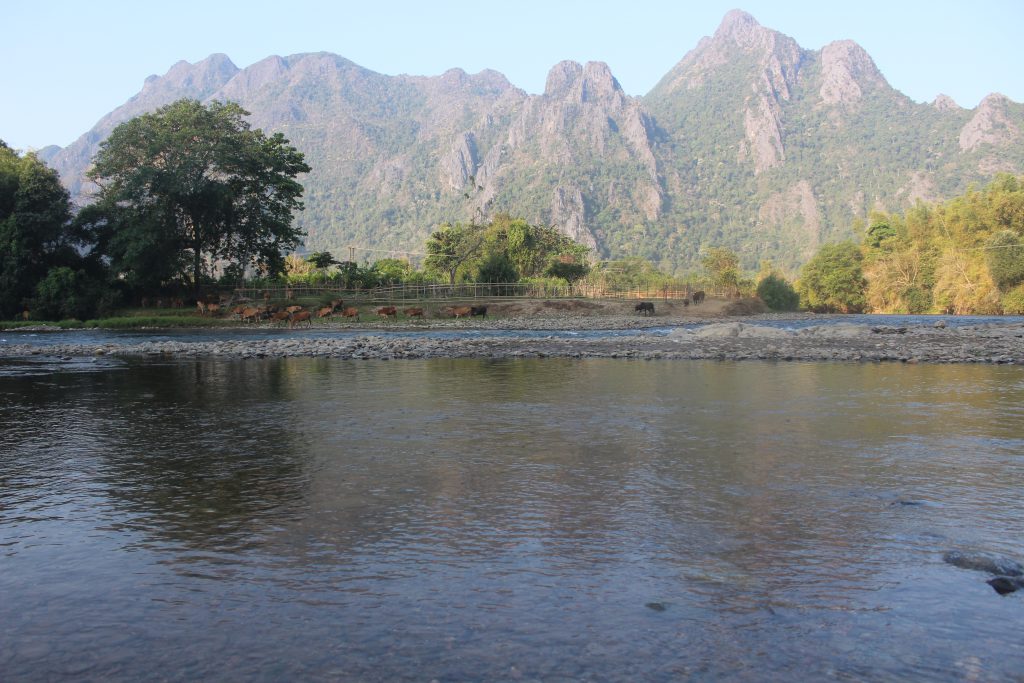Vientiane Province
Vientiane Province is a province of Laos, located in the northwest of the country. As of 2015 the province had a total population of 419,090 people. Vientiane Province is a large province, covering an area of 15,927 square kilometres (6,149 sq mi) with 10 districts in mid north-western Laos. The province borders Luang Prabang Province to the north, Xiangkhouang Province to the northeast, Bolikhamxai Province to the east, Vientiane Capital and Thailand to the south, and Xaignabouli Province to the west. The principal towns are Vang Vieng and Muang Phon Hong. The principal rivers flowing through the province are the Nam Song River, Nam Ngum River and the Nam Lik River.
Phou Khao Khouay National Biodiversity Conservation Area is a protected area located 40 kilometres (25 mi) northeast of Vientiane. It was established on 29 October 1993 covering an area of 2,000 km2. Its mountainous topography.

It has a large stretch of mountain range with sandstone cliffs, river gorges and three large rivers with tributaries which flow into the Mekong River. The forests are evergreen, Shorea mixed deciduous forest, dry dipterocarp and pine type; particularly coniferous forest, of mono specific stands bamboo (mai sanod), and fire-climax grasslands.
Ban Na Reserve is a wildlife protected area. The habitat is known for its bamboo, dense forest and wild elephants.
The Mekong Channel upstream of Vientiane Important Bird Area (IBA) is 18,230 hectares in size. As its name implies it comprises an approximately 300 kilometres (190 mi) section of the Mekong Channel upstream of Vientiane city. It is situated in two provinces: Vientiane and Saiyabuli. The topography features braided streams, bushland, gravel bars, open sandy islands, rock outcrops, and sand bars.
Since 2000, tourism in the region has rocketed, with many thousands visiting Vientiane and Vang Vieng every year. In recent years, new investment has gone into the suburbs of Vientiane. Lonely Planet said of the impact of tourism upon the town of Vang Vieng, “The growth of Vang Vieng has taken its toll. Inevitably the profile of the town has changed and the reason travelers first came here- to experience small-town Laos in a stunning setting – has been replaced by multistorey guesthouses. Even the local market has moved to a big, soulless slab of concrete north of the town. In the “Ban Bo village of Thoulakhom District salt extraction is popular part time economic activity. The village is 60 kilometers from Vientiane and the extraction of salt is done by traditional methods.
Although tourism has grown rapidly, most rural peoples still depend upon agriculture for their livelihoods. Vientiane Plain which covers Vientiane Province and Vientiane Municipality is the largest plain in the country. Situated in the lower reaches of the Nam Ngum River Basin, it is one of the nation’s largest food production hubs. The province has a total rice production land area of 66,768 hectares which yields approximately 269,960 tons of rice a year. Other popular crops and produce in Vientiane Province include corn, Job’s-tears, cassava, bananas, limes, cucumbers, sweet tamarin, tobacco, and watermelons.
By 2009, the province had granted nearly 300,000 hectares of land concessions to foreign investors or joint ventures in mining, agro-fuel, rubber, wood, food and other investment sectors. Some notable projects are gold and silver mining of Phu Bia Mining Co.; lignite mineral exploration of Lanexang Economic Development Co., Ltd.; and several Jatropha plantations of KoLao Farm Co., Ltd.
In its 8th Five-Year Development Plan (2016-2020), the Lao government encourages more sustainable agricultural productions that link to processing.
References:
- Wikipedia ‘Vientiane Province’: https://en.wikipedia.org/wiki/Vientiane_Province
- IDP ‘Vientiane Province’: http://www.investlaos.gov.la/index.php/provinces/vientiane-province




